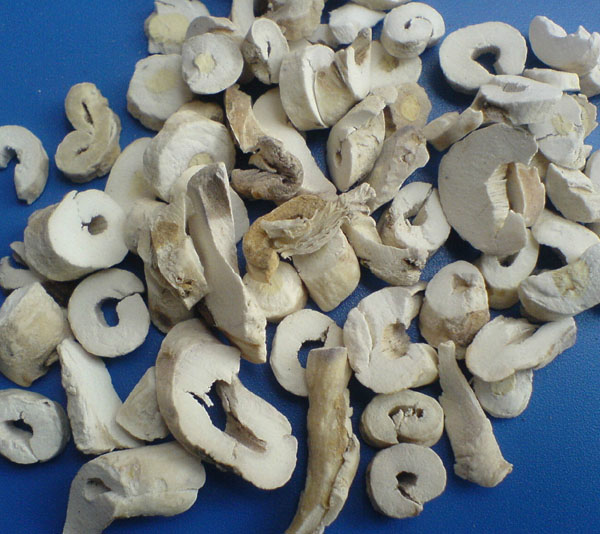Given the fact that tree peony root bark is the main medicinal part, medicinally tree peony refers to the dried root bark of Paeonia suffruticosa Andr., which is a plant in the family Ranunculaceae. Therefore, other names of this herb include Tree Peony Root Cortex, Dan Pi, Cortex Moutan Radicis, Cortex Moutan, Moutan Bark, Tree Peony Bark, moutan root bark, peony bulbs, and so on. In China, it is mainly produced in Anhui, Shandong, and other provinces. After the harvesting in fall, it needs to get rid of the radicula, strip off the root bark, and dry in the sun. It is usually used raw or prepared with wine.
Peony tree is a perennial deciduous shrub, 1 to 1.5 meters in height. Rhizome is fleshy. Branches are short and stout. Alternate leaves are usually biternate compound leaf; handle length is from 6 to 10cm; leaflets are ovate or broad ovate. Large flowers are solitarily grown on the top of the branches; 5 sepals are imbricate and green; petals are 5 or many. Due to variation, most cultivated species are with double flowers, obovate petals, incision on top, and colors of rosy, red, purple, and white; stamens are many, and with red filaments and yellow anthers; pistil are 2 to 5, green, densely pubescent, and with short style, and lobate stigma; faceplate is goblet. Fruits are 2 to 5 follicle-like aggregate fruits, which are oval, green, and covered with brown short hair.
TREE PEONY BENEFITS
Peony has been grown throughout the world for medicinal, ornamental, and landscaping purposes. In addition, it is also a nectariferous plant.
Peony flower is large, colorful, and splendid. That's why it has always been regarded as a symbol of wealth and good fortune in Chinese culture. What's more, it is also called "the queen of flowers" and "national beauty with heavenly fragrance." Nevertheless, it earns such a reputation not by the beauty but the innate pride and dignity. Through a good eye for moutan, being big and showy does not necessarily mean beauty. Instead, what does matter is the attitude – it won't become conceited with full bloom and impudent with gorgeousness. Above all, the most important thing is its strength of character. It is so proud and unyielding that it refuses to bloom when all other flowers are in full blossom. It doesn't cater to anyone's likes and it is always the people who should wait patiently. Perhaps that is the exact reason why it is honored as the queen.
As one of 40 kinds of bulk herbs, it is the main ingredient in a variety of Chinese patent medicine, among which the famous Liu Wei Di Huang Wan (Six Ingredient Pill with Rehmannia) and the relevant series are the biggest source of consumption. And, statistically there are more than 600 pharmaceutical factories, including Beijing Tongrentang, that are producing them. Studies show that its pharmacological and clinical effect is subject to an ingredient called paeonol. That being said, the more peony bark contains paeonol, the better its efficacy it.

Tree Peony
SELECTED TREE PEONY HERBAL REMEDIES
The Chinese Materia Medica believes that it is acrid and bitter in flavor and cool or slightly cold in nature. It goes to meridians of heart, liver, kidney, and lung. Fundamental functions are clearing heat and quickening blood circulation to dissipate stasis. Essential indications include heat entering the blood aspect in epidemic febrile diseases, typhus, vomiting blood, nosebleed, fever due to heat lurked in yin aspect, hectic fever due to yin deficiency, Amenorrhea caused by blood stagnation, Dysmenorrhea, boils, acute trauma (sprains, contusions, and fractures), and pain or numbness caused by wind, dampness, and heat. Recommended dosage is from 6 to 9 grams in decoction, teapills, or powder.
1. Mu Dan Tang from Sheng Ji Zong Lu (Complete Record of Holy Benevolence). It is matched with Zhi Zi (Gardenia), Da Huang (Rheum Palmatum), Huang Qin (Scutellaria), etc. to control acute infectious diseases, such as epidemic cerebrospinal meningitis, ship fever, and so on.
2. Shi Hui San from Shi Yao Shen Shu (The Divine Text of Ten Medicinals). It is coupled with Rhubarb, Da Ji (Cirsium), Xi Cao Gen (Madder), etc. to heal blood-heat causing hematemesis and nosebleed.
3. Zi Shui Qing Gan Yin from Yi Zong Ji Ren Pian (Compiling as Own Duty for Medical Professions). It is combined with Sheng Di Huang (Rehmannia), Gardenia, etc. for the treatment of bleeding from nose and vomiting blood.

![Diseases, Symptoms, tcm, [tcmwindow.com]](/uploadFile/adImg/2015/11/11/f5cbfcc0-4df5-4646-9b9a-f316651a0199.jpg)





